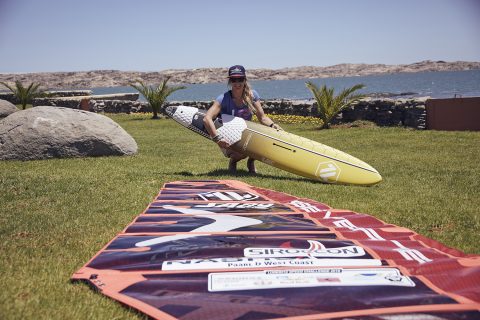SPEEDY RECOVERY: KARO VAN TONDER, LUDERITZ
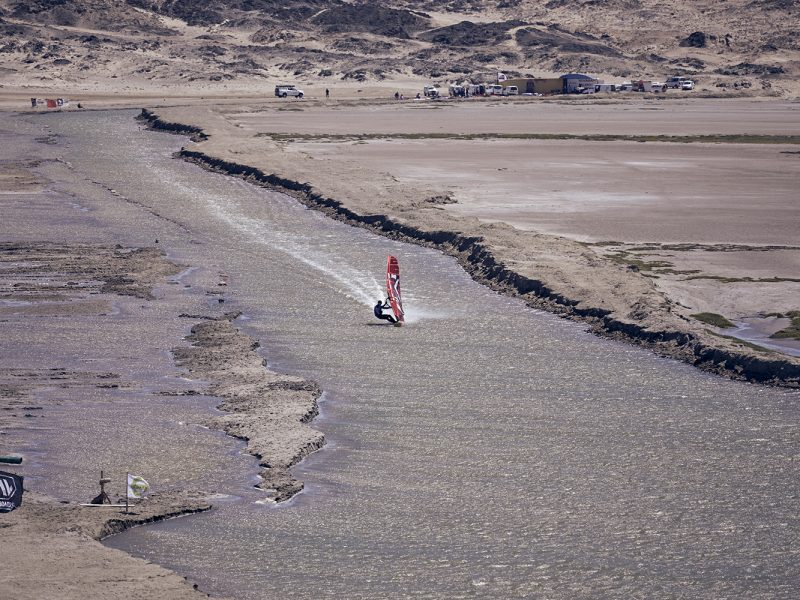
Karo Van Tonder suffered a serious shoulder injury at 2018’s Lüderitz Speed Challenge that required surgery. Far from setting her back however, she set her sights on entering the 2019 Lüderitz Speed Challenge! Karo tells us more about her accident and inspiring comeback journey.
Photos: Stefan Csáky and Karo Van Tonder
PAIN
Lying in hospital with excruciating pain after my shoulder operation, I had zero mobility in my shoulder. The dislocation happened as result of a freak accident the previous year at Lüderitz. I was standing in the stop area, absolutely exhausted from the physical input it required to break my African record during my last run. As I was holding tight onto my gear, a monster gust ripped my sail from under my arm with great force, causing it to fly miles away and left me with a severely dislocated shoulder. Due to the impact, my entire labrum was torn off, ligaments ripped and bone damaged. Fortunately my dad is a doctor and he was able to pull my shoulder back in place within 15 minutes after the accident – those were the most painful moments of my life. At first we decided to let it heal by itself, but due to the high level of instability, it dislocated again while doing normal daily life activities and I had to get it operated on.
REHAB
After the operation, I was restricted to wearing a sling 24/7 for a month, which left me with only 3 months to prepare for the 2019 Lüdertiz Speed Challenge. For a windsurf addict like me this was a nightmare. The orthopaedic surgeon said it would take 18 months to grow together again 100%, and until that time I would have a great risk for dislocation again, range of motion limitations and limited workload allowance. Regardless, I decided to stay positive and put in everything I had to prepare for the world speed record. Dedicated and determined, I started with my physiotherapy a day after my operation. After a month I was freed from the sling. I had lost all of my fitness and strength and could barely lift up my arm. Every day I spent a minimum of 3 hours doing rehabilitation training. After three months of intensive work and the help of my physiotherapist and biokineticist, I managed to get my shoulder mobility back just in time. Being so limited in strength, I knew that my sailing technique would have to be up to the highest possible level on the channel.
EQUIPPED
When going down that narrow, shallow canal at such high speeds in winds so strong they make rocks fly through the air, there is no better thing than knowing you can rely 200% on your gear. I was provided with a custom made AV 37 cm wide speed board, shaped by my new board sponsor, Aurelio Verdi, a legend in the board shaping world. Severne made a custom 5.0 speed sail for me and Gasoil fins provided me with a pair of neatly shaped speed fins. My kit was all ready to go for it!
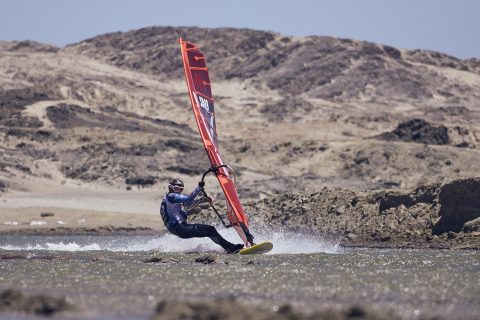
A CHALLENGE
Lüderitz is situated along the southwest coast of Namibia. This little quaint town experiences some of the most brutal wind conditions in the world and is therefore the perfect location to set world speed records. Windsurfers from all over the world come to push their limits on the man-made canal, which is about 7 metres wide and 40 cm deep! The town and landscapes literally look like the moon… rocky hills and sandy dunes with the odd succulent plant here and there. Being the lightest and youngest this year, getting back onto the canal in the middle of the desert with winds gusting over 50 knots was, on its own, a big mental challenge for me. The most valuable skill that one can have is the ability to keep yourself calm and collected so that you are able to make quick, rational decisions. Listening to music before I went on the canal each day helped calm my nerves by shutting out the harsh sound of the wind. The most priceless aspect for me this year was having my dad with me. When operating in these winds from the morning to afternoon non-stop, there is no better thing than having someone who helps you to rig, hands you bananas and coke while you sit in the starting box and helps you make quick gear changes when the wind changes. A big bonus is that he is also my doctor in case things go wrong. I wanted to continue my journey from where I left off last year at 41.3 knots with a dislocated shoulder; there was unfinished business.
STARTING TECHNIQUE
My first priority was to return in one piece and secondly, to improve my African speed record, even if only by half a knot. On day one I got into things very smoothly and was stoked that I managed to waterstart the smallest board I’ve ever sailed, a 43 litre AV speed board that was 37 cm wide. The waterstarts at Lüderitz can be one of the most difficult skills to master, but it is also the most important aspect that determines your average speed down the canal. A perfect start leads to a high entry speed that gives you enough momentum to maintain it through the lulls. There are two types of starts on the canal: ‘water starting’ and ‘jump starting’. Personally I prefer the ‘water start’, because, being very light, the wind can gradually lift my sail and I up and I have control over how much wind I allow under my sail at the right moment as I lift it up. When ‘jump starting’ in very strong winds the gust hits your sail full on and you go from zero to maximum power in the sail in split seconds. This is a lot of instant power to manage for someone my size and the risk of getting tossed right over the front is high. For the bigger guys, the ‘jump start’ is definitely the preferred method, because they can do a forward motion push before jumping on, creating momentum to the front that is just enough to carry them through all the motions of getting feet in the straps and hooking in without sinking and crashing their fins. However, when the wind gets really nuclear, even they prefer doing water starts. Whether ‘water starting’ or ‘jump starting’, the challenge is to be as light as possible on your feet, to prevent sinking in the lulls and hitting your fin on the bottom of the shallow canal.
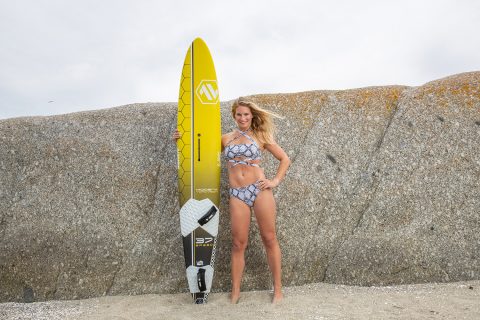
WEIGHT MATTERS
Just imagine being loaded with a 10 kg lead weight and getting up on such a narrow board in winds gusting 50 knots! Your timing is crucial. The more speed you have before you hit the slingshot, the safer you are down the line. It’s almost like running away from a lion that’s chasing you – you need to hit the corner at a high enough speed so that the first monster gust don’t throw you off from behind. When water starting, you have the advantage of being in the straps from the word go and you don’t have to hop around on the board while managing the heavy gusts to get your feet into the straps. Any tiny movement of your feet on such a small board can have a huge effect on how it behaves, which makes this kind of water start a lot more technical than a normal one on open waters with a big slalom board. When I’m on the plane, I always aim to pitch as high as possible onto the upwind bank just before the turn. This way I can make a very sharp downwind turn, throw my bodyweight backwards and sheet in as hard as possible to harness the first gust on the slingshot. This motion provided me with insane acceleration around the corner so that I am fast enough to manage the heavy gusts going downwind, as well as maintain high speed through the lulls. The more weight you have on you, the more momentum you have and the higher the speed you will be able to maintain through the lulls. The additional weight also helps to keep the board down and your body stable through the gusts.
CONFIDENCE
Run by run, I built up my confidence and effortlessly consistently hit 40 knots average. Previously, hitting 40 knots was like reaching the top of Mount Everest! Every day I tried to do as many runs as possible in order to hit the perfect window of wind. My strategy was to stay on the same board, sail and fin and only change lead weight – thereby becoming fully tuned into my gear. I consistently used 5 kg lead in my impact vest on practice days to train myself to waterstart and operate with it like it was part of my body. Going down the channel I tried to keep my position locked all the way down without relying on my arms. I pressed as hard as I could onto the fin for acceleration, pushed my entire body out over the side of my board and hung completely into my waist harness – my hands just there to make tiny adjustments to the sail when gusts would hit. Contrary to mainstream speed sailing technique and styles, I used short 24 cm harness lines. In doing so, my arms were more bent and I had a lot more power and control in my muscles at this angle than with straight arms.
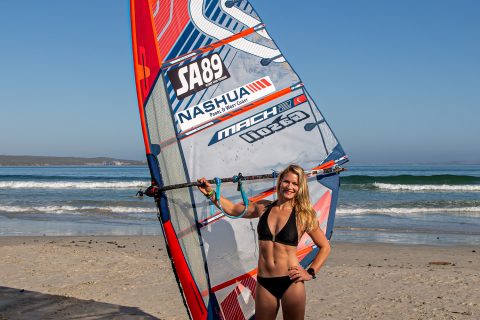
TACTICS
Because of my shoulder injury I needed to find a way to waterstart without relying too much on my arms or shoulder and conditioned myself to lift up effortlessly from a position in the water, lying completely hooked in and feet in the straps. I perfected this manoeuvre and allowed the wind to do the work without too much strain on my shoulder. I believe my wave sailing skills (thanks to my wave teacher husband, Charl) contributed greatly to my skills in the starting block this year and gave me a good balance, mobility and “light feet” to manage the small board with the added lead weight in shallow waters.
I aimed to stay centered going down the channel to give myself space to go a little upwind during a lull and maintain power in my sail all the way down. Your maximum speed is not at all considered in this discipline, it’s the average speed over 500 metres that is the most important and therefore you need to be able to maintain a high speed throughout the lulls.
Being light it’s a big challenge to use all my body weight to push down on my sail as hard as I possibly could onto the water during my downwind 360 degree turn in the finishing block. 30% of the time I was just not heavy enough to put the sail down all the way and it ended up catching a massive gust of wind and flying over my head – almost ending up looking like a freestyle move! If you let go of your gear at this point, it will fly many miles away. Some days it was so choppy in the finishing block that I severely hurt my ankle ligaments by over-flexing as I bounced off the chop leaning forward in my finishing carve. The finishing block gets very shallow very soon. With so little room for error, guys have crashed their boards (and themselves) into pieces.
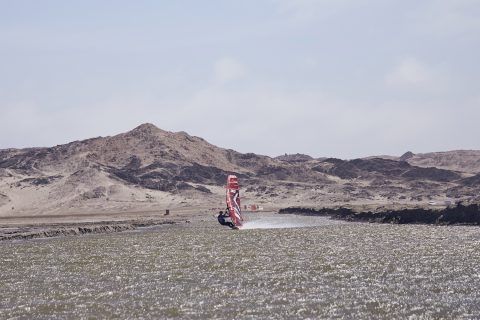
TUNING
We used the same medical strapping my dad put on my shoulder everyday to keep it in place to also cover my boom. This gave an insane amount of grip, though a very expensive operation ha ha! There is absolutely no better boom grip than medical bandages!
This year I had less downhaul on the sail, because I found that this can kill the sail’s profile. My Severne Mach3 speed sail was perfectly designed, with a tremendously deep profile and a lot of twist. The best part was that it rigged perfectly as is from the bag – no adjustments needed. The sail gave me the perfect amount of back vs front hand pressure. If a sail has too little back hand pressure it can easily throw you forward when a gust hits. Gunnar Asmussen showed us how to put in leech tension by pulling the leech line right at the top of the sail towards the mast and making a knot to give the sail even more power. I had my outhaul just loose enough to touch the boom slightly. I prefer using a double-sided boom because it helps to support the sail and maintain its shape. When using one-sided booms there is no support for the sail when over-bagging it past its original shape. This can completely change the dynamics of the sail from what it was meant to be.
The 5.0 was built to rig with a 400 RDM mast, but I used a 370 RDM mast to get maximum softness and flex, allowing the sail to take in the gusts like a shock absorber. When sticking with what I’m familiar with, I have a lot more confidence, control and speed, therefore I used my waist harness at Lüdertiz.
With my boom at its lowest point, my body had a perfect angle to my sail and plenty of leverage over the board to stay low. I learnt to take advice from so many amazing speed legends, but at the end of the day I only used what felt good for me and what worked for my body. Someone double my weight and length might have a completely different setup than me and that is just physics!
My new AV speed board was a total game changer for me and flew over the water with a perfect amount of lift from the front, minimising drag. My sweet spot for fin size was 18.5 cm. When using a smaller fin I had too little lift. As soon as I put in a slightly larger fin I gained more lift from the back and the board levelled out perfectly. I also learned from Vincent Valkanaers that the bigger the fin you are able to use, the better you will be able to maintain your speed and momentum through the lulls. It’s quite an amazing feeling after the acceleration, when you reach top speeds going down the channel, how speed kit really kicks into “sport” mode. It’s like driving a race car, everything just feels better the faster you go! At top speeds the apparent wind became so severe that it caused a funny vibration to go through the sail and a very low tone humming sound. When a gust hits and you manage to lock it perfectly you gain so much acceleration that you outrun the speed of the wind and experience some wind from the front. Whenever I heard this sound going down the course I knew I was in business!
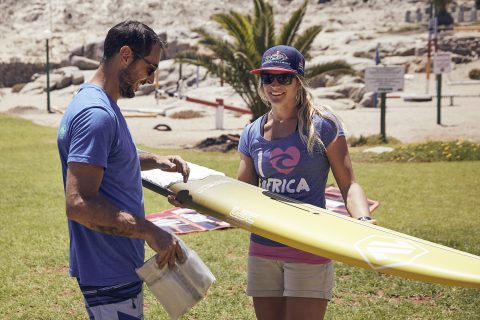
RECORD BREAKING
The record breaking day had arrived. My dad, the optimist that he is, smiled that morning and said, “Hmm I better put on my best shirt for the record breaking interview today”. I laughed and then put on my waterproof lipstick for the same reason. There is nothing better than to have someone with you who so solidly believes in what you are able to achieve, it gave me so much confidence entering this day. Like all the other days on the channel I was the first one to start doing runs. My starts were spotless. Being very light, it was important for me to be on the channel early enough to catch the perfect wind window that is the ideal direction and strength for me to go fast while still being in control of my gear. I found every knot above 40 is extremely hard work to reach. At midday I finally got stuck on 42.8 knots for several runs and was steadily running out of mental, emotional and physical energy. As I was waiting in the line for my next run the wind had picked up to 45 knots, gusting 50 knots. My dad helped me increase my lead weight to 10 kg and then I told him: “I am going to break my record in this next run.” I just knew I had to do it there and then with all the last bit of power left within me. By this time the wind started blowing little rocks and sand over the channel. It would be the strongest winds I have ever taken on in my life with a 5.0 sail. I went into the starting block and sat there holding my sail stable, waiting for my green flag. I took a deep breath and waited for a lull to attempt my start, because the gusts were, at this point, too strong for me to start in. The moment I got up I pushed extremely hard to get to the highest possible speed I could before the first monster gust would hit me at the slingshot.
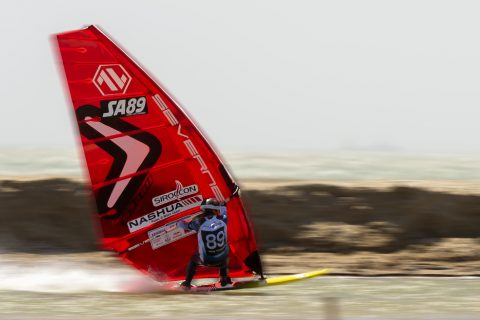
ACCELERATION
The acceleration was intense, an indescribable adrenaline rush. I managed to stay locked down and focussed. It felt like as if I was flying down the channel, barely touching the surface of the water. Everything felt in harmony: my sail, board, fin and my body as a huge amount of force went through it all. I heard that vibration sound again, but this time, it carried on right through till the end of my run and I knew something big had just went down. As I came to a halt, my friend Anne from Spain had just broken her ankle trying to stop and she was helped out of the water at that point. As I approached the trailer I glimpsed down onto my GPS, knowing that, regardless of what it says, I had reached the end of my physical and mental abilities.
It went like a shockwave through my tired body when I saw 44.55 knots on my screen. As I reached the start my dad had his arms up and was running towards me… “44.55 knots!!….. INSANE!!” I wanted to celebrate with him, but not being able to come to terms with it yet, I sat there on the ground next to the channel in tears with absolute pure relief that everything I had worked so hard for and for so long had just paid off in a much bigger way than I could have possibly imagined. Being two knots away from the world speed record, the 5th fastest woman in the world and still in one piece was for me like hitting the jackpot. So there we were, my dad in his best T-shirt and me with my waterproof lipstick still intact after all the sandblasting, having a record breaking interview with Raffi (Raffaello Gardelli the event organiser), who also tried to stay calm from the excitement. This moment was absolutely priceless.
LESSONS
Through my experiences this year, the biggest lesson I’ve learnt is to not let a major setback become a stop sign. Pick yourself up, dust yourself off and go at it again with full force and with a greater amount of inner strength, wisdom and knowledge. The difficult times are what shapes and builds us into stronger humans so we can take on bigger challenges – physical challenges, mental challenges and emotional challenges. This event tests all three of those to the maximum limit. I believe our world and sport today can benefit a lot more from people with good sportsmanship and integrity than people with big titles. This has been and will always remain my biggest priority: promoting my love and passion for this amazing sport and sharing it with the rest of the world.
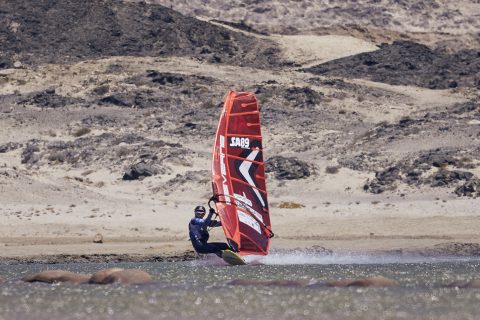
THANKS
I would like to thank Raffaello Gardelli for his amazing work in making this event a world-class experience and turning it into something speed dreams are made of. Thank you to each and every speed legend at the event, my family and followers for all the amazing support (Charl van Tonder, Heidi Ulrich, Louis Naude, Anne Schindler, Aurelio Verdi, Alberto Possati, Gunnar Asmussen, Twan Verseput, Vincent Valkenaers, Carsten Frank, Farrel O’Shea, Pep Bonnet, Stefan Csaky…the list goes on). A big thanks to Severne Sails for all the expertise that goes into making these powerhouse custom sails and to my new board sponsor, AV Boards, for shaping me the fastest little speed board! Gasoil fins, thank you for the awesome fins!
Lastly, to my dad, it is priceless to have someone who knows my sailing abilities, my limits, my fears and my emotions off by heart. We have been together through all the highs and lows. My dad and my husband have both been fundamental in each and every achievement I have made in my windsurf journey so far. My dad has a big heart and absolute devotion to helping those around him, being the spirit of the crowd and paving such a smooth, wide open and safe road for me to walk on with confidence. We are a team and, regardless of the result or records broken, we will always remain a winning team.
The post SPEEDY RECOVERY: KARO VAN TONDER, LUDERITZ appeared first on Windsurf Magazine.
Windsurf Magazine https://ift.tt/2VnPypu